- Books Name
- ACME SMART COACHING Biology Book
- Publication
- ACME SMART PUBLICATION
- Course
- CBSE Class 11
- Subject
- Biology
THE LEAF (PHYLLOPODIUM)
Leaves are lateral, flat, green and expanded parts of plant which arise from the nodes on the stem or branches.
Usually leaf has a bud in its axil.
The chief function of leaf is photosynthesis and transpiration.
Parts of a Leaf
A leaf consists of following three parts:
(i) Leaf base (Hypopodium)
Leaves are attached to stem by leaf base.
In some plants, leaf base becomes swollen and is called pulvinus which is responsible for sleep movement e.g., Cassia, Mimosa, bean.
In some plants, leaf base expands into sheath (sheathing leaf base), e.g., grasses and banana (monocots).
A tongue like structure is also present between leaf base and axis in grasses, called ligule.
When the leaf base partially encloses the stem, it is called semi amplexicaul e.g., Prickly poppy, Calotropis procera (Madar); if it completely encloses the stem, it is called amplexicaul e.g., Sonchus, Polygonum.
(ii) Petiole (Mesopodium)
The stalk of leaf is called petiole.
Petiole in Eichhornia becomes spongy and bulbous.
In orange (Citrus), petiole becomes winged.
Petiole is modified to tendrils in Nepenthes.
In Australian Acacia, petiole is modified into leaf like flat structure called phyllode.
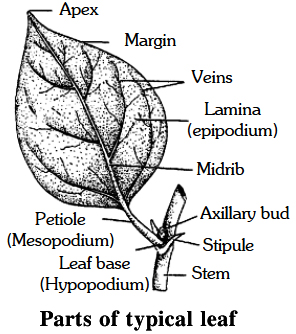
(iii) Lamina (Epipodium)
The broad, green, flat part of the leaf is called lamina ('leaf blade).
All the leaves of a plant are collectively called as phyllome.
Leaves are of the following types -
(1) Cotyledonary leaves: Embryonic or seed leaves, distinct in plants having epigeal germination.
(2) Foliage leaves: Common green, photosynthetic leaves.
(3) Scale leaves (Cataphylls) : Reduced scaly leaves.
(4) Bract leaves (Hypsophylls) : They bear flowers in their axil.
(5) Fertile leaves (Sporophylls) : They bear sporangia on their ventral surface.
(6) First leaf (Prophyll) : First few leaves different from the rest e.g., Citrus.
Prefoliation : Arrangement of leaves in bud condition. It is of two types:
(1) Ptyxis: The manner in which each individual leaf is folded or rolled in bud condition.
(2) Vernation: Arrangement of leaves with respect to each other in bud condition.
Leaf insertion
(1) Radical: Leaves borne on reduced stem, appear to arise directly from the roots e.g., radish, turnip.
(2) Cauline: Leaves found directly on the nodes of main stem e.g., maize, hollyhock.
(3) Ramal: Leaves present on the nodes of the stem branches e.g., Dalbergia, Zizyphus.
Types of Leaf
A. Simple leaf
Leaf which may be entire or incised, and the incisions do not touch the midrib e.g., mango, banyan.
B. Compound leaf
Leaf blade is incised upto midrib or petiole thus, divides it into two or more leaflets.
They are of two types :
(1) Palmately compound leaves. It has no rachis and all the leaflets are joined to a common point i.e., at the tip of petiole. They may be :
(i) Unifoliate e.g., Citrus (lemon and orange).
(ii) Bifoliate e.g., Bignonia.
(iii) Trifoliate e.g., Dolichos, Trifolium, Aegle, Butea
(iv) Quadrifoliate e.g., Marsilea, Paris
(v) Multifoliate e.g., Bombax (silk cotton tree)
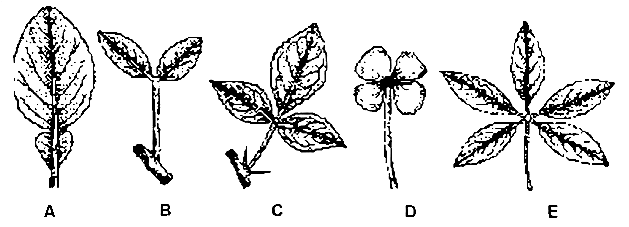
D. Quadrifoliate; E. Multifoliate (digitate)
(2) Pinnately compound leaves. Rachis bears a number of lateral leaflets. These may be :
(i) Unipinnate. Midrib of the leaf directly bears the leaflet and is now called rachis. The unipinnate compound leaf is called paripinnate when terminal leaflet is absent (leaflets are in even number) e.g., Cassia, Tamarindus or imparipinnate when terminal leaflet is present (leaflets are in odd number) e.g., Rosa, Tephrosia, Azadirachta.
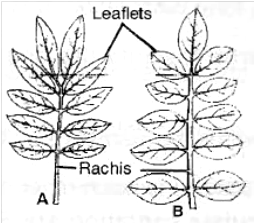
(ii) Bipinnate. Midrib produces secondary axis or branches which bear leaflets e.g., Acacia, Mimosa, Delonix.
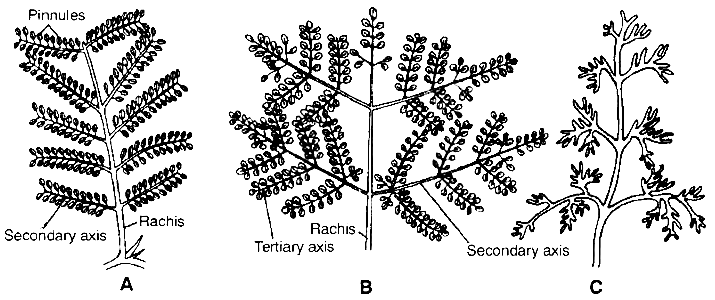
(iii) Tripinnate. Secondary axis produce tertiary axis which bear leaflets e.g., Moringa, Melia.
(iv) Decompound. Rachis is divided repeatedly without any definite pattern so that the lamina is dissected into narrow segments e.g., Carrot, Parthenium, Coriandrum.
Venation in Leaves
Arrangement of veins and the veinlets in the lamina is called venation. It is of three types :
1. Reticulate venation.
The branches of veins form a network, e.g., dicots. However there are some dicots which show parallel venation e.g., Calophylum, Eryngium and Corymbium. It may be
(i) Pinnate or unicostate : Having only one midrib which gives rise to lateral veins bearing vein lets forming reticulation e.g., Peepal , China rose.
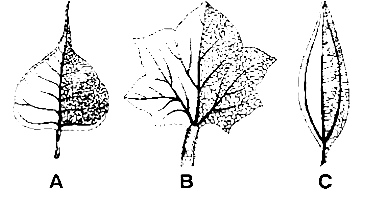
B. Palmate (multicostate) divergent; C. Palmate (multicostate) convergent
(ii) Palmate or multicostate : Many veins arise from the tip of the petiole and reach the apex or margins of the lamina. Their lateral veins form reticulation. It is of 2 types
(a) Convergent : Veins is converge towards the apex of the lamina e.g., Zizyphus and Smilax (a monocot) .
(b) Divergent: Veins diverge towards the margins e.g., Castor (Ricinus), Luffa, Vitis (grape vine), etc.
(2) Parallel venation. The veins remain parallel to each other and veinlets are inconspicuous e.g., monocots. Some monocots which show reticulate ventation are Smilax, Dioscorea, Alocasia, Colocasia.
(i) Pinnate or unicostate parallel venation - Only one principal vein (midrib) is present and lateral veins run parallel without reticulation, e.g. , Banana, Canna
(ii) Palmate or multicostate parallel venation - Many principal veins arise from the base of the lamina. They may be:
(a) Convergent e.g., Bamboo, Grasses
(b) Divergent e.g., Fan palm
(3) Furcate venation - The veins branch dichotomously but the reticulum is not formed by the finer branches e.g., Adiantum (fern), Circeaster (angiosperm).
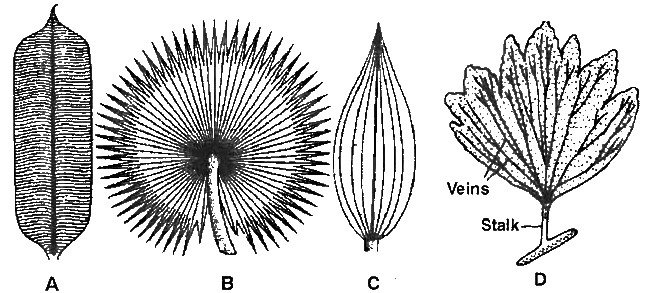
C. Palmate (multicostate) convergent D. Furcate venation
STIPULE
Small, lateral, leaf like appendage which arises in pair from the petiole axis of leaf is called stipule.
Stipule gives protection to the young axillary buds.
Leaves having these are called stipulate, while not having these are called exstipulate.
They may be of following types :
(i) Free lateral. On either side of leaf e.g., China rose, cotton.
(ii) Adnate. United with petiole e.g., Rose.
(iii) Ochreate. Form tube like covering e.g., Polygonum .
(iv) Scaly -Small membranous stipules e.g., Desmodium
(v) Axillary or intrapetiolar -Situated within the petiole towards axis e.g., Gardenia
(vi) Interpetiolar -Situated between the petioles of opposite leaves. e.g., Anthocephalus, Ixora.
(vii) Bud scales -Protect the young bud e.g., Ficus.
Modification of stipules
(1) Tendrillar stipule. In Smilax, stipule changes into tendril and helps in climbing.
(2) Foliaceous stipule. In Pisum and Lathyrus, stipules become leaf like.
(3) Spinous stipules. In Acacia and Zizyphus, stipule is modified into spines.


Types of stipules : A. Free lateral stipules, B. Adnate stipules, C. Interpetiolar stipules,
D. Intrapetiolar stipules, E. Ochreate stipules, F. Foliaceous stipules, G. Bud scales,
H. Tendrillar stipules, I. Spiny stipules
Phyllotaxy
It is the mode of arrangement of leaves on the stem or its branches. It is of following types :
(1) Alternate. Single leaf arising at each node, e.g., Mustard.
(2) Opposite. Leaves occurring in pairs at the node. They may be :
(a) Decussate. Leaves that stand at right angle to upper or lower pair of leaves at nodes, e.g., Calotropis, Sacred basil, Zinnia.
(b) Superimposed. Successive pair of leaves stand directly over a pair in the same plane, e.g., Psidium (Guava), Syzygium (Jamun), Quisqualis.
(3) Whorled. More than two leaves at each node, e.g., Nerium, Alstonia.
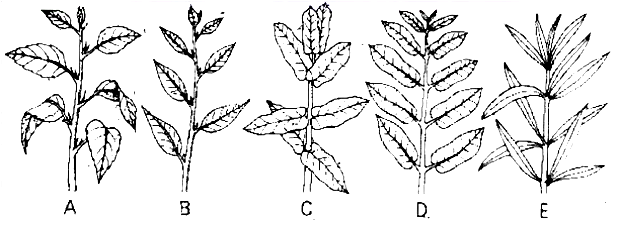
D. Opposite superimposed; E. Whorled
 Modification of Leaves
Modification of Leaves
(1) Storage leaves - e.g., Members of family Crassulaceae have thick succulent leaves which store water (hydrophillic colloids). Such storage leaves prevent the leaf against desiccation e.g., Bryophyllum.
(2) Leaf tendrils : These coil around the support and help the plant to climb.
(3) Spines: e.g. , Opuntia, Berberis . This is a xerophytic adaptation, as spines reduce transpiration loss, besides it helps to protect the plant from grazing animals.
(4) Phyllode: e.g., Acacia auriculiformis (Australian acacia). Here, the leaflets fall off early and petiole becomes flattened to function as leaf. This is also a xerophytic adaptation.
(5) Insect catching leaves - e.g., Nepenthes, Drosera, Utricularia, etc.
(6) Scale leaves -Small dry membranous, brownish leaves, e.g., Casuarina, Ruscus.
(7) Coloured leaves - Leaves near inflorescence are brightly coloured to attract the insects, e.g., Euphorbia pulcherrima (Poinsettia).
The Leaf
The organ of plant that generates the major lateral appendage on the stem of vascular plants is referred to as a leaf. The leaf is a lateral, flattened structure that grows from the stem. It grows at the node and produces a bud in the axil. A branch arises from the axillary bud. Shoot apical meristems give rise to leaves, which are organized in an acropetal order. They are the most essential photosynthetic vegetative organs. It's also known as the plant's kitchen or food factory. This is due to the fact that they are the primary organ responsible for photosynthesis, which is how the plant obtains its energy or food. The presence of chlorophyll gives them their green color.
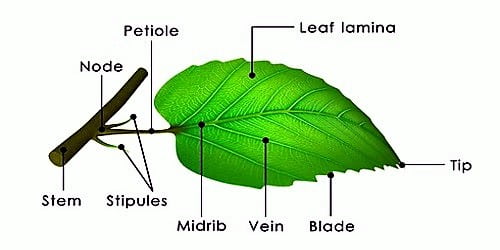
The leaf base, petiole, and lamina are the three main sections of a normal leaf. The leaf base connects the leaf to the stem, while stipules are two lateral tiny leaf-like structures. In monocotyledons, the leaf base develops into a sheath that partially or completely covers the stem. The pulvinus occurs when the leaf base of some leguminous plants becomes inflated. The petiole aids in keeping the blade lit. Leaf-blades flap in the breeze, cooling the leaf and delivering fresh air to the surface, thanks to long thin flexible petioles. The leaf blade, or lamina, is the extended green section of the leaf with veins and veinlets. There is frequently a conspicuous middle vein, referred to as the midrib.Veins give the leaf blade structure and serve as routes for water, minerals, and food components. The shape, edge, apex, surface, and extent of lamina incision vary amongst leaves.
Venation: Venation is the arrangement of veins and veinlets in the lamina of a leaf. The venation is called reticulate when the veinlets create a network. Examples: Hibiscus, papaya, leaves of Tulsi, Coriander, China Rose, and Mangifera. A type of reticulate venation pattern in which the secondary veins run parallel to each other from the midrib toward the margin is called pinnate venation. Examples include Alder, Chestnut, and Oak. Palmate is a venation pattern in which several main veins radiate outward from the base of the leaf. Examples are, Maple, Tulip etc. The venation is called parallel when the veins inside a lamina run parallel to one other. Example: banana, grass, and wheat. Most dicotyledonous plants have reticulate venation on their leaves, but most monocotyledons have parallel venation.A vascular arrangement in leaves such that the veins are forked, with each vein dividing at intervals into smaller veins of approximately equal size is called Dichotomous venation, for example, Ginkgo biloba.
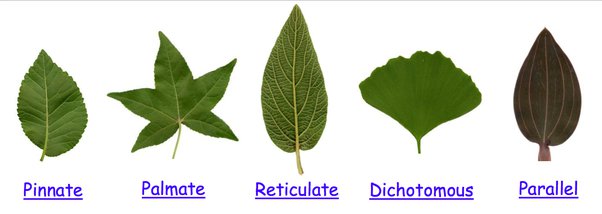
Types of leaves:
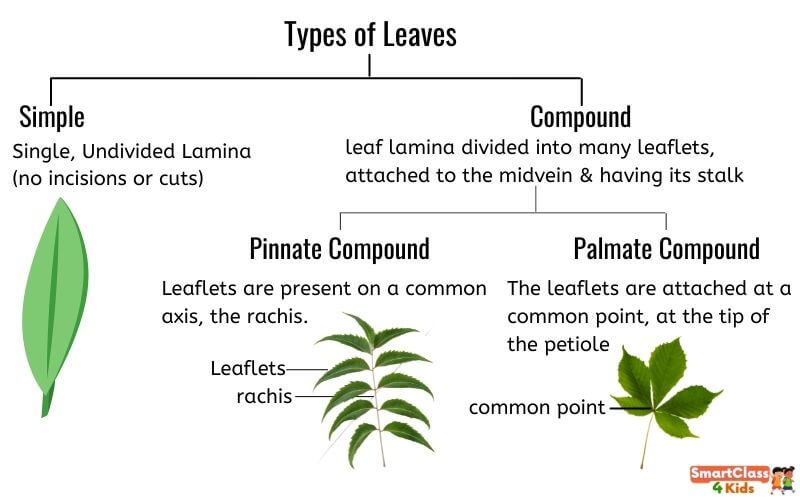
Different types of leaves are described below:
a) Simple leaf: When a leaf's lamina is complete or when the incisions do not touch the midrib, it is considered to be simple.
b) Compound Leaf: The leaf is considered compound when the incisions of the lamina go up to the midrib, breaking it into a number of leaflets. There are two types of compound leaves. As in neem, a pinnatelycompound leaf has a number of leaflets on a common axis, the rachis, which represents the leaf's midrib. The leaflets of palmately compound leaves are joined at a common point, the tip of the petiole, as seen in the silk cotton plant.
In both simple and compound leaves, a bud can be found in the axil of the petiole, but not in the axil of the leaflets.
Phyllotaxy:
The pattern of leaf arrangement on the stem or branch is known as Phyllotaxy. There are three varieties of this: alternate, opposite, and whorled. In alternate phyllotaxy, a single leaf emerges alternately at each node, as seen in China rose, mustard, and sunflower plants. As in Calotropis and guava plants, a pair of leaves emerges at each node and lies opposite each other. This is the opposite phyllotaxy. It is called whorled when more than two leaves emerge from a node and form a whorl, as in Alstonia.
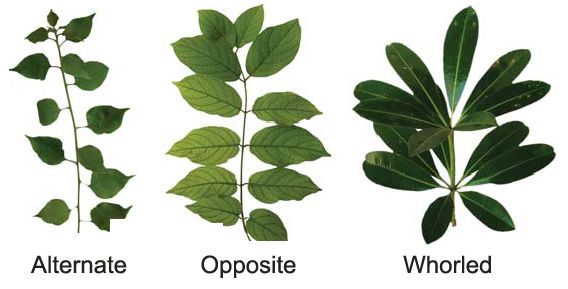
Modifications of a leaf:
Additional to photosynthesis, leaves are frequently adapted to fulfill other purposes. They are transformed into tendrils in peas for climbing and spines in cacti for defence. Onion and garlic leaves have fleshy leaves that store nourishment. The leaves of some plants, such as Australian acacia, are tiny and short-lived. These plants' petioles swell, turn green, and synthesize nourishment. Certain insectivorous plants, such as pitcher plants and venus fly traps, have modified leaves as well.
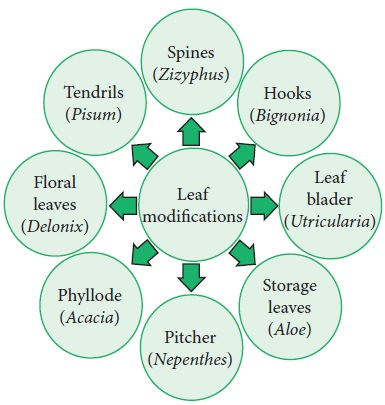

 ACME SMART PUBLICATION
ACME SMART PUBLICATION
